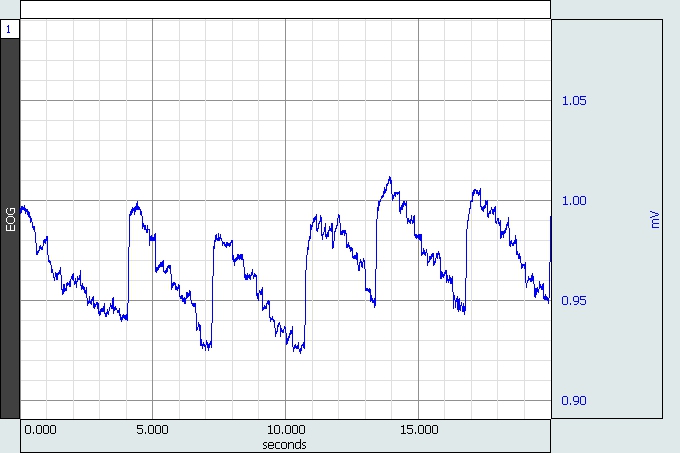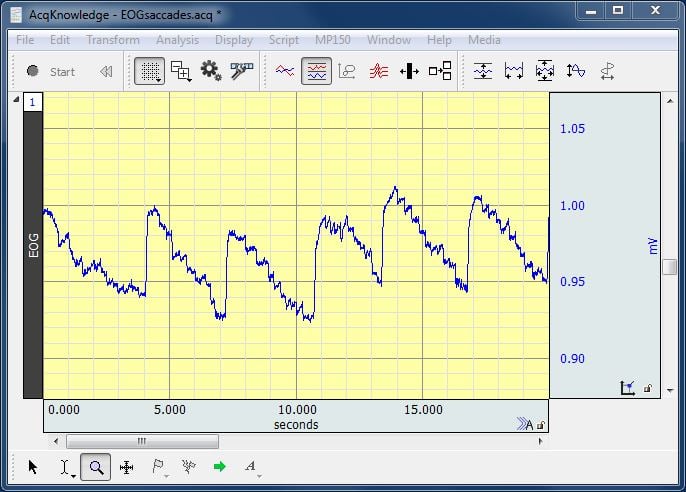EOG: Eye Movement
Precision Wired & Wireless Eye Movement Solutions
Record eye position and movement, or observe vestibular response or “jitter”
Calculate movement rate, direction, frequency, distance, and velocity.

Precise EOG Recording & Analysis
Record and analyze eye position and movement, or observe vestibular response or “jitter” wirelessly with BioNomadix®, or with tethered amplifiers and the powerful MP150 research system. For precise pupil tracking and movement analysis choose from a variety of complete eye tracking systems for binocular and monocular assessments. Use AcqKnowledge® tools to calculate movement, rate, direction, frequency, distance and velocity. For attention studies, use the X/Y plotting function to track eye travel and point of focus during or after data collection. For eye travel studies and reading experiments, use AcqKnowledge® to process raw EOG data to isolate signal behavior associated with nystagmus, saccades and microsaccades. Present visual, auditory, or electrical stimulation via stimulus presentation programs including SuperLab, E-Prime, or Vizard and record corresponding EOG responses.
Try EOG tools in the free AcqKnowledge Demo
See More...Hardware Packages | EOG: Eye Movement
Hardware Bundles are complete solutions for the specified application. Choose your preferred platform and bundle, then click "Request Pricing" to request an estimate, add/remove items, or complete purchase. If you have questions about specific items, click through to the product web page for details and specifications, or contact your Local Sales contact.
Wired
-
MP36R System plus leads & reusable Ag-AgCl electrodes
Wired | EOG: Eye Movement
MP36R with AcqKnowledge plus two lead sets and reusable Ag-AgCl snap electrodes
-
MP36R System plus Ag-AgCl electrodes
Wired | EOG: Eye Movement
MP36R with AcqKnowledge plus TP Ag-AgCl electrodes and electrode lead adapter
-
MP160 System + EOG Amp and reusable 4 mm surface electrodes
Wired | EOG: Eye Movement
MP160 with AcqKnowledge plus EOG Amp & reusable 4 mm surface electrodes
MP36R System plus leads & reusable Ag-AgCl electrodes
- 1 x MP36R Systems
- 1 x Ag-AgCl Reusable Snap Electrodes
- 1 x Adhesive Disks
- 1 x Electrode Gels
- 2 x Lead set, shielded, BSL
- 1 x Abrasive Pads 10/pk
MP36R System plus Ag-AgCl electrodes
- 1 x MP36R Systems
- 4 x Ag-AgCl Electrodes
- 1 x Ag-AgCl Electrodes
- 1 x Adhesive Disks
- 1 x Electrode Gels
- 2 x Electrode Lead Adapter, TP
- 1 x Abrasive Pads 10/pk
MP160 System + EOG Amp and reusable 4 mm surface electrodes
- 1 x MP160 Data Acquisition Systems
- 2 x Module Extension Cables
- 4 x Ag-AgCl Electrodes
- 1 x Ag-AgCl Electrodes
- 1 x Adhesive Disks
- 1 x Electrode Gels
- 2 x Electrooculogram Amplifier
- 1 x Abrasive Pads 10/pk
- 1 x Electrode Impedance Checker
Wireless
-
MP160 System plus wireless EOG & reusable 4 mm electrodes
Wireless | EOG: Eye Movement
MP160 with AcqKnowledge plus BioNomadix wireless EOG & reusable 4 mm snap electrodes
MP160 System plus wireless EOG & reusable 4 mm electrodes
- 1 x MP160 Data Acquisition Systems
- 1 x Electrode Leads - BioNomadix Wireless
- 3 x Ag-AgCl Reusable Snap Electrodes
- 1 x Adhesive Disks
- 1 x Electrode Gels
- 1 x BioNomadix 2Ch Wireless EOG Amplifier
- 1 x Abrasive Pads 10/pk
- 1 x Electrode Impedance Checker
MRI
-
MP160 System + EOG amp with MRI cable/filter and RT electrodes
MRI | EOG: Eye Movement
MP160 with AcqKnowledge plus EOG amp with disposable radio-translucent electrodes
MP160 System + EOG amp with MRI cable/filter and RT electrodes
- 1 x MP160 Data Acquisition Systems
- 1 x MRI Filtered Cable Sets
- 3 x Leads - RT for MRI
- 1 x Electrode Gels
- 1 x Electrooculogram Amplifier
- 1 x Disp. Radiotranslucent Electrode, 100/pk
- 1 x Abrasive Pads 10/pk
- 1 x Electrode Impedance Checker
Animal
-
MP160 System + EOG Amp and needle electrodes
Animal | EOG: Eye Movement
MP160 with AcqKnowledge plus EOG Amp & needle electrodes
MP160 System + EOG Amp and needle electrodes
- 1 x MP160 Data Acquisition Systems
- 2 x Module Extension Cables
- 5 x Needle Electrodes - Animal/Tissue
- 2 x Electrooculogram Amplifier
- 1 x Electrode Impedance Checker
Details
Available BIOPAC® EOG solutions include:
- BioNomadix® Wireless Dual-Channel EOG Amplifiers with the MP150 System
- Mobita® 32 channel Wearable EOG & Biopotential system (wireless live or logged data)
- EOG100C Tethered amplifiers with surface electrodes, active electrodes, or needle electrodes and the MP150 system
Use AcqKnowledge® to process and analyze data from pupil tracking camera based systems. Record with fixed head, moveable head, HMD, or scene camera solutions from BIOPAC® or import data from other eye tracking providers. AcqKnowledge® includes an automated SMI import feature that allows SMI eye tracking data to be seamlessly integrated with physiological data.
- BIOPAC® offers a variety of Eyetracking systems for pupillary analysis.
All of the system options (MP150, and Mobita) include powerful AcqKnowledge® software.
AcqKnowledge® displays EOG data in a variety of formats for quick and easy viewing. On-line calculation channels allow you to configure channels and filtered EOG signals in real time. In addition, AcqKnowledge® includes a range of fully automated routines provide quick, easy and reproducible results.
Videos
Support
Application Notes
- 154 - High Level Transducer Connections - HLT100C
- 159 - Hand Switch and Foot Switch - TSD116 Series
- 126 - Wireless Remote Monitoring - TEL100C-RF
- 136 - Battery Pack Instructions - BAT100
- 185 - iMac and G3 Compatibility Issues
- 195 - MP System Data Sampling Reference
- 207 - UDP Install: MP150 + No Network Access
- 208 - UDP Install: MP150 + Domain Network Access
- 209 - UDP Install: MP150 + Network Access or Multiple Computers
- 120 - X/Y Loop Area Analysis
- 121 - Waveform Data Reduction
- 143 - Importing AcqKnowledge Data Into Excel
- 155 - AcqKnowledge File Formats for the Macintosh
- 156 - AcqKnowledge File Formats for PC With Windows
- 191 - Digital I/O Channels
- 204 - AcqKnowledge Peak Detector Operation
- 218 - Hardware API
- 219 - Known Issues - AcqKnowledge
- 102 - Biopotential Amplifier Testing With CBLCAL
- 001 - AcqKnowledge Release and OS Compatibility
- 288 - How to Turn Events into Graph Channels
Knowledge Base
- * CLEANING GUIDELINES *
- AC mode
- AcqKnowledge accuracy
- AcqKnowledge backwards compatibility
- Amplifier baseline offset adjustment
- Amplifier conversion - 2 mm to touchproof
- Amplifier filter settings
- Audio recording synchronization
- Band-pass and band-stop filters
- Biopotential amplifier signal validation
- Buffer overflow
- Calculating file sizes
- Combining Video with AcqKnowledge
- Common mistakes/general troubleshooting
- Connecting the TSD116C Switch Box
- Copy and paste append markers along with data
- DC mode
- Duplicating waveforms
- Editing noisy data
- Electrode Properties - gel and adhesive
- Excel files exported from BIOPAC software open in Excel 'Protected View'
- Exporting Data to SPSS
- External Devices and Channel Contention
- Extracting data segments from a file
- Grounding guidelines
- Guidelines for Psychophysiological Recordings
- High pass filters
- How do I sync my stimulus presentation software with my data acquisition software?
- IIR vs. FIR filters
- Interfacing third-party transducers
- LabView interface
- Low pass filters
- MP150 UDP protocol fixed IP address
- MRI - Triggering
- Notch filter
- Optimal ground placement
- Outputting a signal through the STM100C
- Physiological measurements - life science signals using BIOPAC
- Railing signal (flatline)
- Recording good data
- Text files - import and export
- Upgrading from PCMCIA to USB
- USB Drivers and Controller Communication
- Using other software with BIOPAC hardware

Stay Connected